Segmentation of 3D Tubular Tree Structures in Medical Images ...
Segmentation of 3D Tubular Tree Structures in Medical Images ...
Segmentation of 3D Tubular Tree Structures in Medical Images ...
You also want an ePaper? Increase the reach of your titles
YUMPU automatically turns print PDFs into web optimized ePapers that Google loves.
3.5. Dicussion and Conclusion 63<br />
3.5 Dicussion and Conclusion<br />
In this chapter, we were concerned with the group<strong>in</strong>g and l<strong>in</strong>kage <strong>of</strong> tubular structures <strong>in</strong>to<br />
complete tree structures. Therefor, two methods have been presented: (a) a structurebased<br />
approach has been presented (Section 3.2) that is capable <strong>of</strong> group<strong>in</strong>g/separat<strong>in</strong>g<br />
tubular structures <strong>in</strong> case <strong>of</strong> multiple <strong>in</strong>terwoven tree structures <strong>in</strong>to valid tree structures<br />
and (b) an image based methods has been presented (Section 3.3) for extraction <strong>of</strong> centered<br />
l<strong>in</strong>kage paths. In Section 3.4 we studied these two methods <strong>in</strong> several examples show<strong>in</strong>g<br />
some <strong>of</strong> their properties.<br />
As shown by these examples, the GVF-based approach for identification <strong>of</strong> tubular objects<br />
and for extraction <strong>of</strong> l<strong>in</strong>kage paths between these tubular objects allows us to extract<br />
high quality curve skeletons directly from gray value images. This approach comb<strong>in</strong>es the<br />
advantages <strong>of</strong> a bottom-up tube detection filter with the GVF’s ability for extraction <strong>of</strong><br />
medial curves, also <strong>in</strong> cases where the tube detection is perturbed due to larger deviations<br />
from the typical tube shape such as furcations, stenosis, or aneurysms. The presented<br />
image based l<strong>in</strong>kage approach allows for extraction <strong>of</strong> medial curves also <strong>in</strong> these areas.<br />
We showed that the accuracy <strong>of</strong> the result<strong>in</strong>g centerl<strong>in</strong>es is comparable to that achieved<br />
with state <strong>of</strong> the art skeletonization approaches that are all based on the same known segmentations.<br />
Thus, the result<strong>in</strong>g CSs are directly applicable for tasks requir<strong>in</strong>g high quality<br />
skeletons and this supersedes the need to deal with segmentations and skeletonizations <strong>in</strong><br />
these applications.<br />
However, as shown <strong>in</strong> the experiments, pure image based methods are not capable <strong>of</strong><br />
handl<strong>in</strong>g disturbances such as overlapp<strong>in</strong>g tubular tree structures or cases where parts<br />
<strong>of</strong> the tubular tree structure are not identifiable <strong>in</strong> the image doma<strong>in</strong> (e.g. the tumor<br />
<strong>in</strong> case <strong>of</strong> the airway tree; see Fig. 3.4). In such a case, only some k<strong>in</strong>d <strong>of</strong> centerl<strong>in</strong>e<br />
<strong>in</strong>terpolation can be utilized as done with our structure based approach. As we showed <strong>in</strong><br />
the experiments, the presented structure based approach allows a separation <strong>of</strong> <strong>in</strong>terwoven<br />
overlapp<strong>in</strong>g tubular tree structures and handl<strong>in</strong>g <strong>of</strong> various k<strong>in</strong>ds <strong>of</strong> disturbances, but it<br />
cannot guarantee a centered path <strong>in</strong> these disturbed regions.<br />
Also a comb<strong>in</strong>ation <strong>of</strong> the two approaches could be applied, us<strong>in</strong>g the image based<br />
l<strong>in</strong>kage path extraction <strong>in</strong> cases <strong>of</strong> deviations from a tubular shape and a l<strong>in</strong>ear centerl<strong>in</strong>e<br />
<strong>in</strong>terpolation <strong>in</strong> case <strong>of</strong> imag<strong>in</strong>g artifacts or partly overlapp<strong>in</strong>g tubular tree structures.<br />
Therefor the validity <strong>of</strong> the centerl<strong>in</strong>e paths extracted with the image based method should<br />
be verified based on structural properties and additional l<strong>in</strong>ear centerl<strong>in</strong>e paths added <strong>in</strong><br />
case the structure based method requires a l<strong>in</strong>k between two tubular structures. This















